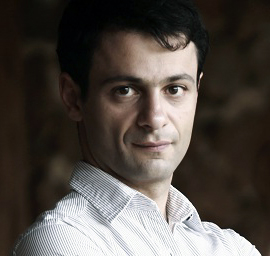Prof. Artem R. Oganov [Skolkovo Institute of Science and Technology, Russia]
Title: Computational Materials Discovery: a Dream that is Becoming Reality
Time: 10:00-11:00 AM, Tuesday, August 25, 2015
Place: Auditorium room 410, HPSTAR (Shanghai)
Host: Dr. Bin Chen
Abstract:
Thanks to powerful evolutionary algorithms, in particular the USPEX method [1-3], it is now possible to predict both the stable compounds and their crystal structures at arbitrary conditions, given just the set of chemical elements. Recent developments include major increase of efficiency and extensions to low-dimensional systems and molecular crystals [4] (which allowed large structures to be handled easily, e.g. Mg(BH4)2 [5] and H2O-H2 [6]) and a new technique called evolutionary metadynamics [7].
Some of the results that I will discuss include:
1. Theoretical and experimental evidence for a new partially ionic phase of boron, γ-B [8] and an insulating and optically transparent form of sodium [9].
2. Predicted stability of “impossible” chemical compounds that become stable under pressure – e.g. Na3Cl, Na2Cl, Na3Cl2, NaCl3, NaCl7 [10], Mg3O2 and MgO2 [11].
3. Novel surface structures (e.g. boron surface reconstructions [12]).
4. Novel dielectric polymers, confirmed by experiment and ready for applications [13].
References
[1] Oganov A.R. et al, J.Chem.Phys. 124, 244704 (2006).
[2] Oganov A.R. et al, Acc. Chem. Res. 44, 227-237 (2011).
[3] Lyakhov A.O. et al., Comp. Phys. Comm. 184, 1172-1182 (2013).
[4] Zhu Q. et al, Acta Cryst. B68, 215-226 (2012).
[5] Zhou X.-F. et al, Phys. Rev. Lett. 109, 245503 (2012).
[6] Qian G.R. et al. Sci.Rep. 4, 5606 (2014).
[7] Zhu Q. et al, Cryst.Eng.Comm. 14, 3596-3601 (2012).
[8] Oganov A.R. et al, Nature 457, 863 (2009).
[9] Ma Y. et al, Nature 458, 182 (2009).
[10] Zhang W.W. et al, Science 342, 1502-1505 (2013).
[11] Zhu Q. et al., Phys. Chem. Chem. Phys. 15, 7796-7700 (2013).
[12] Zhou X.F. et al., Phys. Rev. Lett. 113, 176101 (2014).
[13] Sharma V. et al, Nature Communications 5, art. 4845 (2014).
Biography of the Speaker:
 Prof. Artem R. Oganov was born on 3 March 1975 in Moscow, Russia. He graduated from Moscow State University in 1997 with summa cum laude and diploma in Crystallography and Crystal Chemistry. In 2002 obtained a PhD degree in Crystallography from University College London, and in 2007 got a Habilitation degree from ETH Zurich. From 2008 he is at Stony Brook University, as Professor and Director of the Center for Materials by Design.
Prof. Artem R. Oganov was born on 3 March 1975 in Moscow, Russia. He graduated from Moscow State University in 1997 with summa cum laude and diploma in Crystallography and Crystal Chemistry. In 2002 obtained a PhD degree in Crystallography from University College London, and in 2007 got a Habilitation degree from ETH Zurich. From 2008 he is at Stony Brook University, as Professor and Director of the Center for Materials by Design.
Oganov has published over 150 scientific articles (many in top journals, e.g. Nature, Science) and book chapters. He is an author of 5 patents. Total citations >7600, h-index 45.
He is a laureate of several prestigious awards, including an ETH Latsis Prize, Research Excellence Model of the European Mineralogical Union, three most-cited paper awards from Elsevier. In 2001, Forbes ranked Oganov among 10 most successful Russian scientists. In 2012, highly acclaimed cinema director, Laureate of State Prize Vladimir Gerchikov made a film "The color of a crystal" about Oganov. In 2012, Oganov became a Professor Honoris Causa of Yanshan University (China), since 2013 he is a Fellow of the Mineralogical Association of USA. In 2013, magazines "Russian reporter" and "Expert" have listed Oganov among 100 most influential Russians today.
His most significant works are in fields of computational materials discovery, in particular the effects of pressure on chemical bonding, and state of matter at extreme conditions (e.g. inside the Earth and other planets). He has developed novel methods of crystal structure prediction that became basis of the USPEX code, used by >2500 researchers worldwide. Among the highlights are the discovery of the structure of a superhard phase of boron, gamma-B, transparent phase of sodium, new carbon allotrope, stability of MgSiO3 post-perovskite in the Earth's mantle, and prediction of "forbidden" compounds (e.g., Na3Cl)
